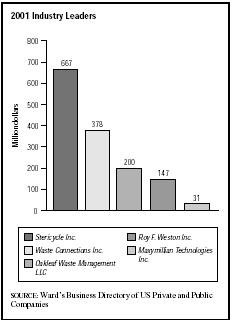SIC 4959
SANITARY SERVICES, NOT ELSEWHERE CLASSIFIED
This category includes establishments primarily engaged in cleanup and maintenance activities that are not classified in other sanitary industries. Activities covered by this industry classification include beach maintenance and cleaning, malaria control, mosquito eradication, oil spill cleanup, snowplowing, street sweeping, and vacuuming airport runways.
NAICS Code(s)
488119 (Other Airport Operations)
562910 (Remediation Services)
561710 (Exterminating and Pest Control Services)
562998 (All Other Miscellaneous Waste Management)
The 2001 industry leader was Stericycle Inc. of Lake Forest, Illinois. Stericycle boasted $667 million in revenue and 2,600 employees. In second place was Waste Connections Inc. of Folsom, California, with $378 million in revenue and 2,400 employees. Oakleaf Waste Management LLC of East Hartford, Connecticut, was third with $200 million in revenue and 200 employees. Other notable companies in this industry were Roy F. Weston Inc. of West Chester, Pennsylvania, with $147 million in revenue and 1,800 employees, and Maxymillian Technologies Inc. of Pittsfield, Massachusetts, with $31 million in revenue and 200 employees.
Most establishments in the industry are small, local companies that operate on a contract basis, typically for business and municipal clients. For instance, many firms that offer commercial snowplowing, street cleaning, and runway clearing services are small, family-operated businesses. These companies typically act as subcontractors and bid on service contracts for property managers, government agencies, or institutions. The labor and capital intensive nature of sanitation services, combined with the competitive bidding process, results in characteristically low profit margins for industry participants. Furthermore, low barriers to entry create an extremely competitive pricing environment.
An example of an entrepreneurial company in this industry is the Greater Philadelphia Commercial Residential Services Co. (CORS). Started in 1996 as a graffiti-removal company, CORS could not turn a profit because business owners were unwilling to pay for services they believed should be paid for by local government or the graffiti wrongdoers. Since CORS' company assets already included vehicles with mounted pressure washers, the company broadened its market by offering industrial cleaning and environmental services. In 1999, services

included pressurized surface cleaning, street cleaning, and interiors cleaning. Corporate revenues went from an $11,000 loss in 1997 to nearly $1.2 million in 1999.
Some 1,200 establishments performed miscellaneous sanitation services in the United States in the 1990s. They employed approximately 8,000 laborers and generated receipts of more than $700 million. Such firms benefited from an emphasis by commercial property managers on increased maintenance to retain tenants. This, combined with moderate growth in government spending, was partially offsetting increased competition and stagnant prices among sanitary industry participants.
Environmental awareness of unhealthy conditions has helped the industry. In 1999, the U.S. Environmental Protection Agency (EPA) began publishing survey results of approximately 935 public beaches that regularly monitor water quality. The EPA's own review of 1,062 coastal beaches and the Great Lakes the previous year indicated that 350 had an advisory or closing. Beach maintenance often was contracted out to private companies, but remained a local responsibility. In Hollywood, Florida, for example, the public works division purchased a sanitizer that cleans the beach sand and redistributes it along its 5 miles of beaches. Each year, crews collect more than 500,000 pounds of litter, and 440 cubic yards of shoreline debris.
A bright spot in the industry has been oil spill cleanup services. This segment was benefiting from stringent new federal regulations enacted during the cleanup of the 11 million gallon Exxon Valdez spill in 1989. Notwithstanding, in that incident, less than 50 percent of the rescued wildlife had survived. Ten years and $45 million later, 1999 populations for the bald eagle and river otter appeared to have recovered. Sea otters, harbor seals, harlequin ducks, herring, salmon, and one pod of killer whales were reported as "not recovering." With respect to salmon, in 1999 patches of residual oil could still be found adjacent to some intertidal spawning habitats, having a continued negative impact on salmon embryos, according to the National Marine Fisheries Service (NMFS).
Many companies and city governments established oil spill readiness plans that provided for quick mobilization of spill cleanup contractors in the event of an emergency. Companies most likely to benefit in this sector are those that have access to the latest technology related to disaster cleanup equipment and chemicals. Major companies in the industry included Waste Management Inc. (formerly WMX Technologies) of Oak Brook, Illinois; and Handex Environmental Recovery Inc. of Morganville, New Jersey.
By the new millennium, increasing numbers of Americans were washing with antibacterial soaps, drinking bottled water, employing the latest electronic pest deterrents, and contributing to environmental charities in record amounts. According to a 1999 study released by the American Enterprise Institute, this was with good reason—it found that basic public health measures, including "drinkable water and sanitation services," have the greatest effect on life expectancy.
Industry leader Stericycle handled waste management for nearly 300,000 medical clients, including hospitals and blood banks. The medical waste was treated in one of three ways: incineration, autoclaving, or electrothermal deactivation (ETD). Items considered medical waste range from blood and blood products themselves to single use items, such as needles or syringes, which work with blood or blood products. The company's revenue continued to increase each year, more than 10 percent from 2003 to 2003 alone.
Further Reading
Baker, Deborah J., ed. Ward's Business Directory of US Private and Public Companies. Detroit, MI: Thomson Gale, 2003.
Hoover's Company Fact Sheet. "Stericycle, Inc." 3 March 2004. Available from http://www.hoovers.com .
——. "Waste Connections." 23 March 2004. Available from http://www.hoovers.com .
"Stericycle Announces Three New Service Offerings for Hospitals and Other Health Care Providers." 23 February 2004.
Available from http://www.stericycle.com/news_;02_23_04.htm .
"Stericycle, Inc. Reports Results for Fourth Quarter 2003 and Full Year 2003." 10 February 2004. Available from http://www.stericycle.com/news_02_10_04.htm .
Comment about this article, ask questions, or add new information about this topic: